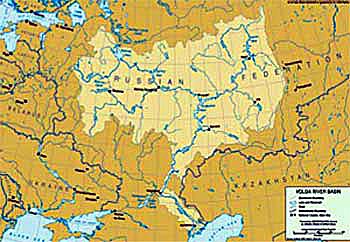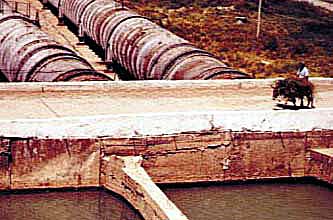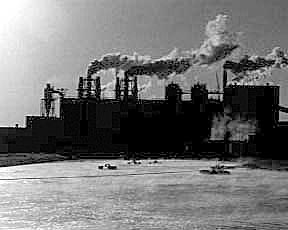| The
Volga River Basin The
main challenge in the Volga basin is dealing with the legacy of the Soviet military
establishment. The Volga basin covers 10% of the total territory of the Russian
Federation, contains 39 Republics, some of them autonomous, and has a population
of almost 60 million. The biggest problems stem from major industrial complexes,
big dams, big cities, controlling pollution and maintaining navigability; all
of which can be traced back to the military complex of the former USSR. The challenge
being faced now is how to change the system that was originally constructed to
meet military and industrial needs of the Soviet Union into one that will support
the movement towards a democratic state and the sustainable development of the
basin. The problem in the meantime is where to find the resources to maintain,
decentralise and diversify the existing system and all of the associated infrastructure,
and how to identify the laws and authorities required to govern water management
under the new political structure of the Federation. Today, the Russian Federation
is in a period of transition; in Soviet times, the different Oblasts were centrally
controlled, now they must make their own decisions, including those about water
management, and pay for them. The Volga basin includes several large cities, each
of which pollutes a reservoir belonging to another further downstream causing
a great deal of provocation and some permanent conflict situations. The oblast
boundaries were drawn-up arbitrarily and cut across the basin. Formerly, conflicts
would have been addressed by the national minister in charge of wate;, with decentralisation
there is no established management system to resolve problems between regions.
The most urgent need is to establish a new system of communication between the
different levels of governance – local, state and national – and begin
to develop a modern management structure. The problem is finding the funds needed
to maintain, de-centralise and diversify the old Soviet system. A clear legal
structure linking the local, state and national levels would help guide and regulate
decision-making. This project aims to provide a first step towards the urgently
needed transition of the management and legislation of the whole basin, to make
people aware of the conflict and environmental disaster potential of leaving matters
as they are, and begin to identify clear strategies to resolve existing conflicts
in a transparent and regulated way.
| 3 This proposal
was prepared by Green Cross Russia, with the close collaboration of Professor
Alexander Kosarikov, Vice-President of the Committee on Ecology of the State Duma,
and Dr. Natalia Davidova, Director of the Non-Governmental Environmental Consulting
Company. GC Russia, Prof. Kosarikov and Dr. Davidova will be the driving forces
behind the Volga River basin component of the Water for Peace project. |
 |
| The Volga River Basin |
 | Background
The Volga river basin covers 1358 thousand km2, spans 39 subjects of the Russian
Federation, some of which are autonomous republics, and two regions of Kazakhstan.
The population of the basin is approximately 57 million persons, including 40
% of the total population of Russia. The run-off of the Volga varies greatly from
year to year; since 1881 the highest river run-off was registered in 1926 at 382
km3, and the lowest was 161 km3, in 1937. The average Volga run-off near Volgograd
is 254 km3. 2600 rivers supply the Volga and its reservoirs directly. The estuary
lies 28 m below the sea level and the difference in elevation from the source
to the estuary is 256 m. The Volga is the main source of water entering the Caspian
Sea, the largest internal-drainage basin in the world, and its biodiversity includes
90% of world sturgeon reserves. The Volga-Kama river system is the main transport
artery of European Russia and is a key link in the structure of the important
Trans- European transport corridors; the volume of traffic reaches 20 million
tons annually.
 |
| Water collection from the Volga |
 | Alongside
the many rivers which form the basin water system, and which are the main source
of drinking and technical water supplies for this enormous region, are a large
number of hydroelectric power stations which provide 13 % of the basin’s
electric power complex. Hydroelectric stations were constructed on the Volga and
Kama with power generation of up to 2.5 million kilowatts (Ivankovo, Uglich, Rybinsk,
Gorki, Cheboksary, Kama, Votkinsk, Nizhnekamsk, Kuibishev, Saratov, Volgograd).
In addition to the hydropower stations, large thermal power stations are also
situated on the Volga basin, including the 2.8 million kilowatts Ryazan and the
3.6 million kilowatts Kostroma, as well as a large portion of the former Soviet
Union’s military complex. The military legacy is a huge burden on the basin,
both in terms of pollution from military industries, storage facilities and former
bases, and because of the cost of maintenance.
Large-scale dam building in the Volga basin has radically altered both the hydrological
and thermal regimes of the Lower Volga and the delta of the river. The creation
of a cascade of large reservoirs, especially on the Lower and Middle Volga, have
led to huge losses in run-off due to additional evaporation from their surfaces.
Coupled with unsustainable water consumption, especially in connection with the
development of irrigation, the river run-off is now only 10 % of the natural levels.
The dams and reservoirs have also reduced the volume and duration of floods, broken
the natural seasonal dynamics of run-off, given rise to winter floods, eliminated
stocks of sturgeon and other fish species, and negatively effected conditions
for spawning. Overall catches of river fish have been reduced to less than a quarter
of the1930 level.
 |
| Pollution on the banks of the Volga |
 | The
creation of the artificial lakes cascade on the Volga reduced the speed of the
stream and increased bacterial pollution by more than 10,000 times. Additional
pollution is caused by the approximately 450 oil and gas fields in the basin,
producing approximately 80 million tons of oil and 40 billions cubic meters of
gas annually. This has resulted in a steep rise in the cost of drinking water,
and necessitated the use of new, more power-intensive and expensive methods of
water treatment. Poor
environmental conditions in the region also impact on the low natural increase
of the population compared to the average Russian rate. The basin includes only
8% of Russian territory, but 45% of its industry and 50% of its agriculture is
located here. Environmental pollution in the Volga region exceeds the average
Russian indexes of atmosphere, soil and water pollution by three to five times.
65 of the 100 Russian cities with the most polluted air are situated in the Volga
basin. Approximately 42 million tons of toxic waste are produced in the Volga
basin annually, but only 13 of them are managed or treated. As a result, the total
quantity of toxic waste at dumps and banks has reached 900 million tons. No more
than 3% of the total surface water resources can be described as “clean”.
Organic compounds used in agriculture are the main cause of surface water pollution,
as 50 - 70% of fertiliser and pesticide reserves are stored in the open air in
the Volga region. The insecurity of storage, transport and use of such compounds
leads to 30% mineral fertilisers loss. More than 400,000 tons of organic compounds
are discharged in Volga every year. The total annual discharge of oil by-products
is up to 18,000 tons, surface- active substances up to 6,000 tons, ammonia nitrogen
up to 100,000 tons, phenols 90,000 tons, and zinc up to 1,000 tons. Not
surprisingly under the circumstances, not one single Volga basin city is currently
provided with drinking water which conforms to the standard of the Russian Federation.
None of the cities located within the territory of the Volga basin has a storm
waters sewerage system to clean surface discharge to meet basic requirements.
According to statistics, 21 km3 of sewage water is discharged into surface waters
of the Volga basin annually, including 11 km3 of under-treated and non-treated
sewage. Despite
other differences, the transboundary requirements for water treatment and water
supply, as well as the level of financing of the corresponding services, are practically
identical. About 50 % of the municipal budgets in the Volga basin are dedicated
to housing expenses. One reason for this high percentage is that here is no integrated
insurance system of hydraulic engineer facilities safety, leaving regional budgets
to cover expenses of the flood control measures. The competition between areas
in using water resources is already fierce, and if pollution and other water problems
continue to deteriorate this competition could lead to conflicts. The most serious
situation is in the hydropower industry as optimal difference of water levels
from the hydropower point of view leads to fast waterlogging and bogging of ground,
and the loss of residential areas and agricultural fields in the Volga plains.
These conflicts of interest need to be recognised and addressed.
Main Problems to be Addressed
1. Absence of the legislative and normative base
for sustainable development of the Volga basin and prevention of water conflicts.
2. Insufficient maintenance regime for reservoirs,
including flood control.
3. Ineffective economic mechanism for natural resources
management in the basin.
4. The lack of an effective system of environmental
monitoring in the basin.
5. Inadequate public involvement in conflict resolution
in the water consumption sphere; public opinion has little impact on decision
making.
6. Absence of networking, cooperation, and other
public bodies for the control of water consumption by water users or to protect
the human rights of the local population in water conflict situations.
7. The lack of information on the correlation between
social and environmental factors, the environmental impact on the health, demography,
social stability and well-being of the population needed to increase public awareness
and interest.
8. Poor quality of drinking water in cities and
settlements of the Volga basin and absence of systems of water treatment and sewage
systems management in small cities and settlements.
9. Poor safety of the existing hydraulic engineering
facilities and instability of the coastal zone.
10. Environmentally unfriendly navigation (safety,
channel-cleaning, sewage management on ships). Characteristics
of Conflicts
Project Objectives Expected
Results
1. An elaboration of draft Federal laws ‘On drinking
water supply’; ‘On the protection of the Volga basin’; and ‘On
environmental insurance’, in order to create the mechanisms required for
the conflicts resolution at the Federal level.
2. An elaboration of proposals to regulate the
corresponding legislative acts of the subjects of the Federation situated in the
basin and in the Volga Federal Region in order to resolve the interregional conflicts.
3. A conception of the legal and institutional
basis needed to resolve water conflicts at the interregional level.
4. Development of proposals for water-users cooperation
and networking in order to balance water consumption and resolve/prevent conflicts
at municipal and inter-department level.
5. Increased information of the population about
the links between social and environmental factors: environmental impact on the
health of the population, demography, social stability, and wellbeing, in order
to increase public awareness and interest.
6. Working out a model for the legal solution of
the conflict linked with the Cheboksary hydro-electric power station (see box).
7. Proposals to create a water resources monitoring
network for the Volga basin.
8. Environmental risk assessment of the activities
of hydro-technical facilities, and proposals to create an environmental insurance
system in the Volga basin.
9. Proposals to create a Volga Basin Organisation
necessary for effective water resources management. Activities
- Proposals for drafting
the Federal laws ‘On drinking water supply’; ‘On the Volga basin
protection’; ‘On environmental insurance’.
- Proposals
to regulate the corresponding legal acts of the subjects of the Federation situated
in the Volga basin and the Volga Federal district.
- Development
of the legislative and institutional procedures of water conflict resolution at
the interregional level.
-
Development of a procedure for the legal resolution of conflicts based on the
case study of the Cheboksary hydroelectric power station.
- Proposals
to create the Volga basin water resources monitoring network.
- Environmental
risk assessment of the hydrotechnical facilities activity and proposals for the
environmental insurance system.
- The
elaboration of proposals for the cooperation of water-users in order to balance
water consumption, and resolve and prevent conflicts at municipal level.
-
Proposals to create the Volga Basin Council.
- Proposals
to create a Volga Basin Organisation for effective water resources management.
-
Organisation of a section entitled ‘The Water Use Conflicts’ at the
international conferences ‘The Great Rivers - 2002 ‘ and ‘The Great
Rivers - 2003‘.
- Organisation
of public hearings on the Cheboksary hydroelectric station conflict.
- A
round table with participation of the representatives of cities administrations
and regions the Volga Federal district, Legislative Assemblies, Ministry of Natural
Resources, NGOs.
- The information
of the population about water conflict solutions (newspaper articles, video film
about conflict situations, a website of the project, brochures and the project
report).
| The
dam creating the Cheboksary reservoir is the last of the Volga cascade, situated
down-stream of Nizny Novgorod. It is important that the dam is in Chuvash republic
– an autonomous subject of the Russian Federation. The construction of the
dam began in the1970s but the hydro power station remains unfinished. After the
filling of the reservoir, low lying sections of Nizny Novgorod and some agricultural
lands were flooded and further rising of the reservoir level was stopped. From
the point of view of energy efficiency the reservoir level must be raised, but
a lot of land up-stream will be lost. Every spring, Nizny is threatened with floods.
The Chuvash republic’s interest in "cheap" energy means a loss
of territories, rise of ground waters in the Mary-Al Republic, and floods in the
Nizny Novgorod area. No legal procedure exists for the resolution of such conflicts,
so the relations between Nizny Novgorod Oblast and Chuvash Republic remain very
tense. |
Expected
outputs - Development
of the legal and institutional basis to resolve the water conflicts at the inter-regional
and municipal levels.
- Establishment
of networking organisations to foster water-users cooperation and public involvement
in water conflict resolution.
- A
final legal solution of the conflict at Cheboksary hydraulic power station.
- That
the project activity contributes to improving drinking water quality, reducing
the river water pollution from bacteria and oil, stabilizing the consumption of
water space industry and irrigation, and intensifying the protection of the river
bank, and drainage and dredging works.
Project Partners
| 1. Kosarikov A.N. | Doctor
of economical sciences, professor, Vice-president of the Committee on Ecology,
State Duma, RF | | 2.
Davidova N.G. | Ph.D, a director
of the non-governmental agency ‘Consulting company on environmental projects’ |
| 3. Dement’yev V.S. | Head
of the Department of natural resources, the Volga federal district |
| 4. Naidenko V.V. | Doctor
of technical sciences, professor, Rector, Architectural - building university,
Scientific chief of the Federal programme ‘Revival of Volga’ |
| 5. Kruglov V.A. | Head
of the Committee of ecology and natural resources, the Nizhniy Novgorod oblast
Legislative Assembly | | 6.
Horses S.I. | Director, Center
of environmental safety, Administration of the Nizhniy Novgorod oblast |
| 7. Antonova I.A. | Vice-president,
Committee on natural resources, the Chuvash Republic | | 8.
Gaisin I.N. | Vice-president,
Committee on natural resources, Republic of Mary-Al | | 9.
Strelnikova T.G. | Head of the
Environmental Department, Samara oblast Administration | | 10.
Peters E.YU. | Chief sanitarian
doctor, the Nizhniy Novgorod oblast | | 11.
Etin V.L. | Doctor of technical
sciences, professor, the Nizhniy Novgorod Academy of transport |
| 12. Yiakubovskayia N.Yu. |
Ph.D, Leading scientific advisor, Department of natural resources management,
Government of Moscow | | 13.
Mikirticheva E.A. | Ph.D, the
editor, the social and economic department, the regional newspaper ‘Saratov
– Volga’s capital’ | | 14.
Gulyukin M.N. | Ph.D, Russian
chemical–technologic university | | 15.
Mashir Yu.I. | Doctor of technical
sciences, Russian chemical –technologic university |
| 16. Kayumov A.A. |
Director, NGO ‘Dront’, Nizhni Novgorod | | 17.
Bogolyubov S.A. | Doctor of
law, professor | Follow-Up
1.
Realisation of a number of measures on progression of Federal laws ‘On drinking
water supply’; ‘On Volga basin protection’; ‘On environmental
insurance’ in the State Duma, with the involvement of all participants concerned
(subjects of the Federation, administration of the Volga districts, water-users,
NGOs).
2. The development of the Russian legislation on environmentally
friendly navigation.
3. Creation of the Volga Basin Council.
4. Dissemination of
the case study of the legal solution of Cheboksary hydroelectric station conflict
to other hydroelectric stations of the Volga basin.
5. Development
of a water resources monitoring network in the Volga basin.
6. Inventory
of hydraulic engineering facilities of the Volga basin (firstly in the Volga federal
district).
7. The feasibility report for the creation of a Volga Basin
Corporation, with the mandate to develop a unified framework for water resources
management in the Volga basin.
8. Organisation of permanent section
on ‘Water Use Conflicts’ at the annual international conference ‘The
Great Rivers‘.
9. Organisation of a seminar in the Union of Russian Cities on ‘Water
Conflicts between Cities‘. |
